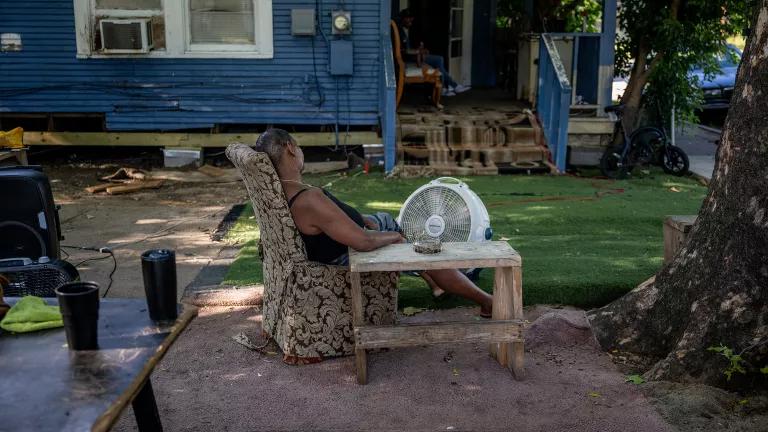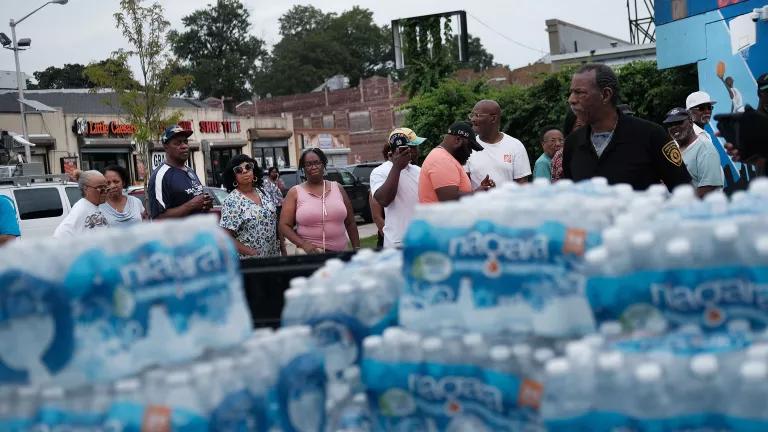Dobbs Is Dangerous, Especially in an Era of Climate Change
In a time when we are experiencing more intense, disruptive climate impacts, the consequences of this Supreme Court decision will be even more harmful and deadly, with Black people and low-income people bearing the worst.
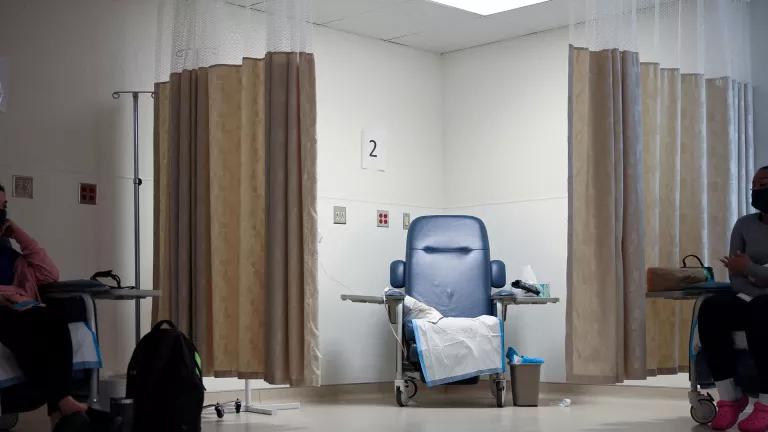
Two women from Texas talk to each other about their traveling to Oklahoma as they wait in the recovery room at the Trust Women clinic in Oklahoma City in December 2021.
The recent Dobbs v. Jackson Women’s Health Organization Supreme Court decision overturning Roe v. Wade and Planned Parenthood v. Casey is sure to be dangerous and deadly. As health and environmental advocates, we are just starting to see the consequences of Dobbs unfold for women and people who can give birth seeking reproductive care in an already unjust health-care system. These barriers come at a time when we’re seeing more intense effects of climate change—for example, when the Supreme Court published the opinion overturning Roe, almost half the nation was in the midst of a record-breaking heat wave. But the burdens of these two dangerous realities are not shared evenly by everyone; the heaviest burdens of both climate change and the Dobbs decision will fall on people of color and low-income people. This decision creates more structural inequality at a time that we need to be dismantling it and building a just, healthy, and sustainable future for all.
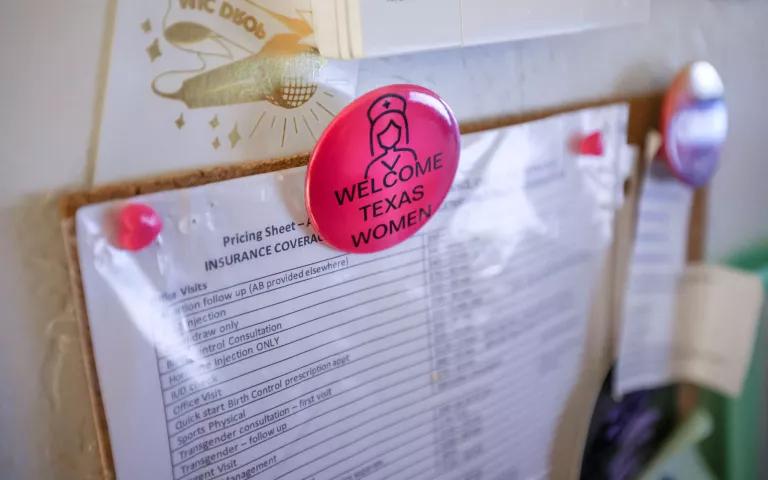
Lack of safe reproductive care harms health—and climate change compounds the risks
Even before Dobbs, the foundation of our reproductive health system was shaky at best, built on long-standing racial health disparities. The United States has long been a dangerous place to be pregnant and give birth, especially for BIPOC groups. Many of the states with the toughest abortion restrictions have some of the highest infant and maternal death rates in the country and some of the worst racial disparities in maternal mortality. During the pandemic, racial disparities widened: Black maternal mortality increased 44 percent from 2019 to 2020 and Latino people experienced a 26 percent increase in maternal mortality. Reducing access to abortion is projected to make things even worse.
Added to this are the environmental burdens—air pollution, unsafe drinking water, and worsening climate effects—that fall disproportionately on women and people who can give birth at any point in their reproductive lives. For example, environmental factors can play a role in conditions like endometriosis and other conditions that cause fertility challenges. Further, exposure to pollution and extreme heat can have negative impacts on pregnancies.
Not surprisingly, climate change makes it all worse. Hurricanes, wildfires, and floods are all on the rise due to climate change, and those disasters tend to make it harder for affected people to access health care of all sorts, including abortion where it’s still available. With serious efforts to roll abortion restrictions into effect in about half of the states, many people will need to travel over state lines to access this service; California, for example could see as many as 1.3 million people from other states seeking abortions annually. On the East Coast, some project that for more than 11 million women, North Carolina will be the closest state with abortion providers after the overturning of Roe. That state—which requires two visits (72 hours apart) to secure an abortion—has been deeply impacted by increased hurricanes and the resulting inland flooding.
Climate change also puts stress on the ability of abortion clinics, which struggle to meet demands even during normal times, to serve additional influxes of patients. Abortion services are especially vulnerable as clinics have unique security needs that often prevent them from relocating temporarily. Further, evidence shows that disasters such as superstorms and hurricanes increase the likelihood of preterm births—and with Roe’s protections gone, people who give birth face a greater risk of intrusive criminal investigations or even prosecutions when they experience unhealthy births, stillbirths, or miscarriages. Climate change increases incidences of sexual and gender-based violence that could give rise to the need for abortions, such as this story about a woman who was raped in a hurricane shelter.
The need for abortion services is already widespread. About 25 percent of U.S. women have an abortion before they are 45, and the majority of abortion patients are already parents. In the many decades after Roe, there was a steady decline in abortion. But on the heels of disrupted health care and reduced access to low-cost family planning services between 2017 to 2020, there was an 8 percent increase in abortions. With 75 percent of people who obtain abortions being at or below 200 percent of the federal poverty line, they face significant barriers to access, such as finding childcare, covering costs, and, now, taking time off from work and paying for travel expenses. As my colleague Khalil Shahyd writes, “Limiting access to reproductive health services disproportionately impacts Black, Latino, and low-income communities across America. Those inequalities lead to negative effects in many other areas, perpetuating gender and racial inequities.”
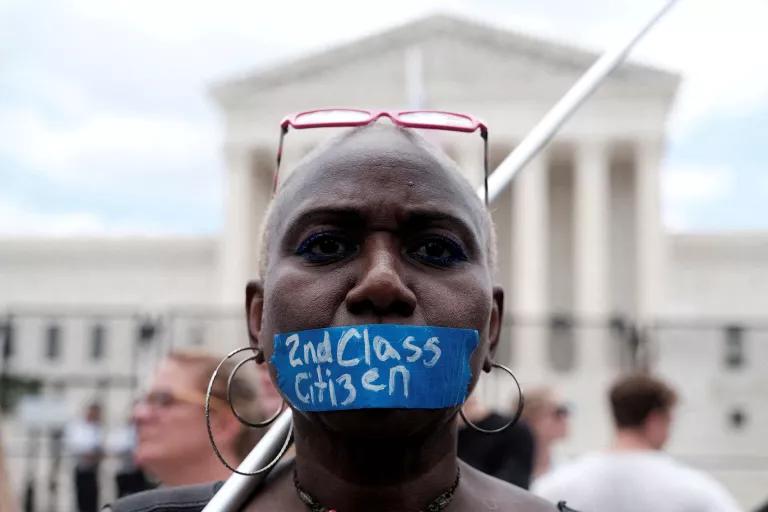
An abortion-rights’ activist outside the Supreme Court in Washington, D.C., on June 24, 2022.
This ruling is a racially unjust decision
Losing access to abortion has serious negative consequences for health, especially along color lines. This has been well documented. For example, being denied an abortion is harmful to mental health, and forced birth is harmful to the person who has to give birth. Additionally, in certain instances, abortions can also save lives.
Abortion bans do not adequately account for the medical necessity of abortion, nor do they stop it. Instead, they increase attempts at self-managed abortions, including dangerous ones, especially for women of color. One study predicts that banning abortion in the United States would increase overall pregnancy-related deaths by 21 percent, and it would increase Black pregnancy-related deaths (which were already disproportionately high) by more than 30 percent. This is simply not acceptable.
Our commitment to racial justice requires us to ask questions about the legacy of segregation and the racist policies that are still reflected in our built environment and infrastructure. This commitment and our analysis of Dobbs compel us to ask about racism at the foundation of our reproductive health-care infrastructure, which the 6-to-3 majority willfully neglected to do in this ruling. Digging into the opinion, the justices assert that there was never a nationally recognized abortion right, but it ignores that abortion was common during the pre–Civil War era, a time when women, both Black and white, were the primary reproductive health-care providers. During Reconstruction and the Jim Crow era—the same period that saw recisions of rights and systematic erosion of wealth from Black people throughout the country—the antiabortion movement took root. Some of the physicians’ groups involved in the antiabortion movement were earnestly concerned with patient outcomes and protections but many of them were openly using the newly formed pro-life movement transparently and intentionally to push women and people of color out of the professional class and out of the business of caring for women by providing midwifery services.
This court decision could be a prelude to many other changes, including those that endanger birth control and other reproductive freedom measures like IVF. You don’t have to be a lawyer or understand terms like substantive due process or stare decisis to see these risks from overturning Roe, or the misogyny, LGBTQ-phobia, or racism that undergirds the coming wave of state laws restricting access to abortion.
To build the just, sustainable, safe world I want for my children and future generations, we must do better
As a person who is looking at all the interconnections between climate, health, and racial justice, I still hold out hope that our children can inhabit a better world, one where the climate is stabilizing and the right to reproductive freedom is protected, no matter the color of your skin or how much money you make. As a mother who has given birth to two wonderful, planned, and badly wanted children, I firmly believe that each person ought to be able to make the decision whether to carry a baby to term—on their own terms and for their own reasons, whatever they may be.
Here at NRDC, we work to secure a healthy, sustainable, and just environment for everyone, and we stand in solidarity with all who are losing access to abortion, a critical health service. The answer to the unique challenges of this time is not to turn back the clock.



